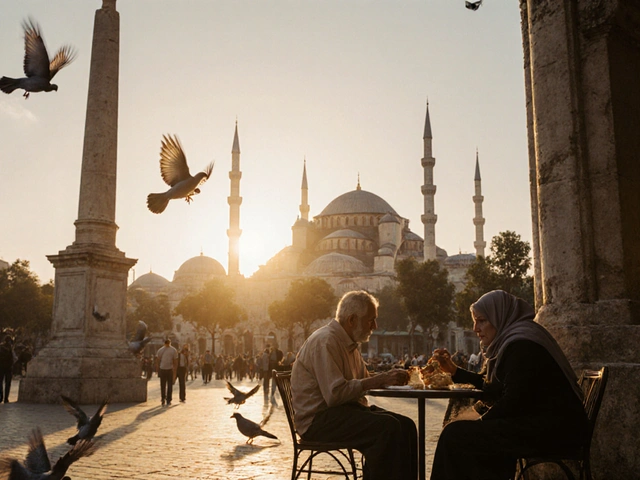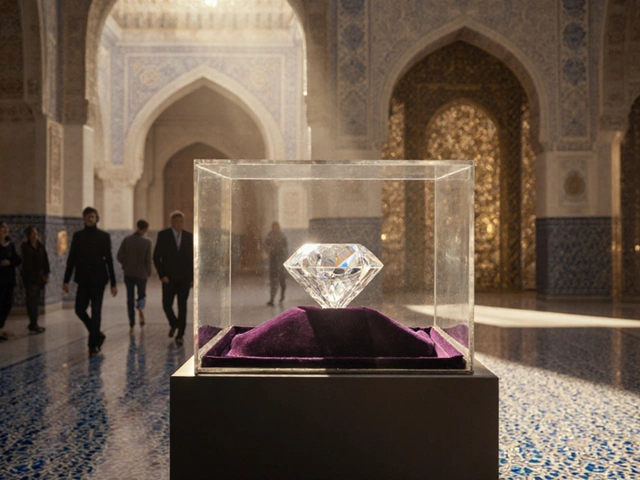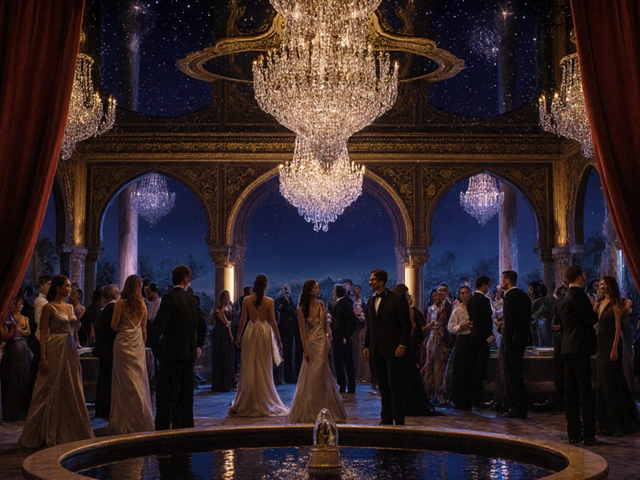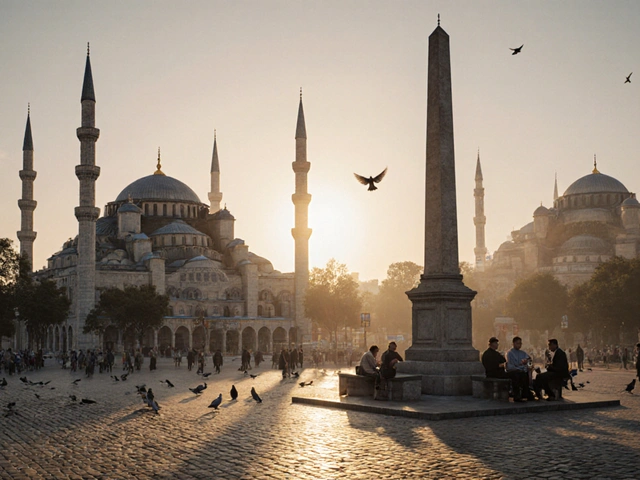We all know a great building when we see one, right? It's like the universe suddenly makes sense, or maybe that's just the coffee talking. But let's chat about how those epic structures do more than just look good. They get the creative juices flowing across art, tech, and design. Don't believe me? Well, let's think about this. The Sydney Opera House isn't just a pretty shell; it's touched painting, music, and even app development. How's that for multi-tasking?
Here's the kicker, though: these buildings shape how we think. They spark the kind of ideas that get artists scribbling in notebooks and engineers dreaming up the next big thing. Seems wild that a building can do all that, but they sure do! And it's not just about soaking in the aesthetic vibes either. Icons like the Eiffel Tower or the Louvre Pyramid make us wonder 'why not push boundaries elsewhere?'
Now, before we get lost in a daydream, let me share a tip: Engage with these marvels more closely. Whether you're strolling past the Sydney Harbour or planning a trip to the Burj Khalifa, take a moment. Let the design sink in. You've got a brainwave experiencing something truly great. And who knows, maybe that spark will lead to the next big thing in your own work!
- Key Insights on Iconic Buildings
- Defining Iconic Architecture
- Multi-Disciplinary Benefits
- Types and Examples of Iconic Structures
- Finding Inspiration Locally
- Tips for Engaging with Iconic Designs
Key Insights on Iconic Buildings
So what's the big deal about iconic buildings? They're way more than just eye candy. These structures have been shaping innovation and creativity across various fields for decades. Take the Sydney Opera House, for instance. It took over 14 years to build and has inspired countless artists with its sail-like design. This isn't just about aesthetics; it's about pushing limits and embracing new ideas.
Historical Influence
Historically, buildings have been symbols of power and innovation. The Pyramids of Giza, for example, aren't just heaps of stones—they're marvels of ancient engineering that continue to awe us today. They demonstrate a blend of art and science that few modern structures can rival.
Even newer structures like the Burj Khalifa have a similar impact. Completed in 2010, its staggering height of 828 meters makes it a feat in engineering and design. While you won't be building a skyscraper at home, the innovation behind these ideas can inspire you in any number of fields.
Modern Implications
In modern days, architecture inspiration comes from integrating technology and sustainability. Just think of London's The Shard with its stunning glass architecture and advanced eco-friendly systems. Buildings like these challenge us to think about balance: beauty mixed with practicality.
"Architecture should speak of its time and place but yearn for timelessness." — Frank Gehry
Frank Gehry, the mastermind behind the Guggenheim in Bilbao, perfectly encapsulates why these buildings stir creativity. They blend the past with future potential, challenging individuals across fields to step out of conventional thinking.
Impact Across Disciplines
But how do these physical structures break barriers in different fields? Well, they're living examples of what happens when art meets technology. Urban planners see them as examples for future cities. Meanwhile, tech startups in Silicon Valley draw parallels between architectural complexity and their digital blueprints for apps—both require vision and meticulous planning.
Remember, these iconic buildings haven't just weathered the test of time—they've inspired it. Architecture inspiration is more accessible than grabbing a passport for Paris or Dubai. Just step outside, look at your city’s skyline, and let it fire up your imagination.
Defining Iconic Architecture
So, what makes a building truly iconic? It's not just about looking cool or towering above a skyline. Sure, a striking design helps, but it's deeper than that. Iconic buildings blend aesthetics with functionality and reflect a moment in cultural or technological history. Think about it: they're snapshots of innovation.
Take the Sydney Opera House. Instantly recognizable, right? Its sail-like shells pushed architectural boundaries when it was completed in 1973. It turned a practical performance space into something that captured the world's imagination. That's a hallmark of iconic architecture—having a design that's not only functional but also sparks creativity.
The Impact of Cultural and Historical Context
Iconic structures often reflect their era's technological advancement or cultural shifts. For example, the Burj Khalifa in Dubai isn't just the tallest skyscraper in the world; it symbolizes human ambition and economic boom. Meanwhile, structures like the Eiffel Tower, which initially faced criticism, have become timeless symbols of art and achievement.
Factors That Make Architecture Iconic
- Innovation: Pushing design or engineering limits, like the use of steel and glass in breathtaking new ways.
- Cultural Significance: Showing what a society values—luxury, efficiency, art, you name it.
- Uniqueness: Standing out due to unusual shapes, scales, or technology used.
In essence, iconic buildings transcend their primary role and enter public consciousness as symbols. They do more than house offices or events; they challenge us to think bigger, inspire us to create, and reflect our world's constant evolution.
Multi-Disciplinary Benefits
Iconic buildings do more than catch our eye—they ignite creativity across many fields. It's fascinating how iconic buildings like the Guggenheim Museum in New York have inspired not just architects, but artists, filmmakers, and tech innovators alike. But how does that happen?
First up, there's the art scene. Buildings like the Guggenheim push artists to explore new dimensions and perspectives. Think about how the museum's unique spiral shape challenges artists to imagine how their work interacts within it. It pushes boundaries, leading to more innovative display methods and even new artistic styles.
Influencing Technology
When we talk about technology, the Burj Khalifa is a great example. The genius engineering behind the world's tallest building inspires software developers to push the boundaries of coding and digital tech. The building's complex design led to advances in building information modeling, a tech now commonly used in construction projects worldwide. This shows the profound impact architecture inspiration can have on technology.
Creativity in Urban Planning
In urban planning, buildings like the Centre Pompidou in Paris lead the pack, affecting cityscapes and public spaces everywhere. The building’s inside-out architecture—that is, its color-coded exterior—revolutionizes how we view utility and aesthetics in public structures. This trend of blending function with form is now a key in urban development projects globally.
Essentially, iconic buildings serve as blueprints for creative thinking. Whether you're in art, tech, or urban planning, these mighty structures prompt us to see what’s possible and rethink our limits. So next time you see a legendary skyscraper or a jaw-dropping museum, remember: it’s more than just architecture, it’s a catalyst for innovation across the board.
Types and Examples of Iconic Structures
Iconic buildings aren't just random cool structures; they define eras, cities, and sometimes entire countries. While each has its own charm and story, a few rise above and change how we think about spaces. Let's break down some types and sprinkle in some famous examples.
1. Cultural Icons
When you think of iconic buildings, cultural wonders surely come to mind first. Take the Sydney Opera House; it's not just Australia that gets bragging rights. It was hailed for its unique design before the building even started. Similarly, the Eiffel Tower was once dismissed as an eyesore, but now it’s practically the emblem of Paris.
2. Engineering Marvels
Skyrocketing innovations in engineering also leave a mark. The Burj Khalifa stands as a literal pillar of human achievement. At over 828 meters, it’s the tallest building out there and a hotspot for videos and selfies. Then there's the Golden Gate Bridge, more than just a way to cross a bay in San Francisco—it's art in steel form and a masterpiece of suspension bridge tech.
3. Ancient Wonders
Don't forget the ancient players. Structures like the Pyramids of Giza made history not just as tombs but as muses for countless architects worldwide. They prove that some designs can outlast times longer than we can even imagine.
4. Modern Green Giants
In our eco-friendly era, buildings like Bosco Verticale in Milan are sprouting up, literally! These ‘green towers’ make the most of vertical forests, combining natural beauty with urban living in a way that’s highly sustainable.
Quick Facts
| Building | Location | Year Completed |
|---|---|---|
| Eiffel Tower | Paris, France | 1889 |
| Sydney Opera House | Sydney, Australia | 1973 |
| Burj Khalifa | Dubai, UAE | 2010 |
| Golden Gate Bridge | San Francisco, USA | 1937 |
Each of these structures tells a different story but share a common thread – they all inspire creativity and keep pushing the boundaries.
Finding Inspiration Locally
If you think you have to travel overseas to soak in some serious architectural inspiration, think again. Right here in Sydney, we've got some jaw-dropping iconic buildings that can spark creativity and new ideas. Talk about inspiration right at your doorstep!
Take the Sydney Opera House, for instance. Its stunning design, intended to mimic the sails of a ship, has been a muse for everyone from musicians to fashion designers. Next time you’re there, pay close attention to how the curves and angles interplay—who knows, it might just give you some fresh artistic insight.
Not far away, we've got the Sydney Harbour Bridge, also known affectionately as the 'Coathanger.' It's more than just a bridge—it's an engineering triumph that's inspired countless innovations in structural design. Got a local project to tackle? Maybe try to incorporate some of that boldness and functionality you see on your next stroll across its expanse.
Feeling artsy? Head over to Barangaroo, a vibrant area showcasing contemporary urban design. Its mix of green spaces and contemporary buildings demonstrates how nature and architecture can coexist so harmoniously. As you wander around, think about how this blend can influence your work, whether you're crafting marketing campaigns or developing eco-friendly apps.
Explore and Engage
Don't just walk past these structures—engage with them. Here’s a little challenge: Try capturing the details in a photo, then use it as a launchpad for brainstorming. Let your surroundings do the talking, and you might be surprised at the ideas they stir up.
- Bring a sketchpad and jot down your thoughts while exploring.
- Join a walking tour for deeper insights into the building’s history and design.
- Collaborate with a peer and discuss how local architecture influences your work.
Finding creativity doesn't have to be complicated or expensive. With these steps, you're not only getting out there but also diving deeper into what makes a space truly innovative.
Tips for Engaging with Iconic Designs
So you're ready to dive into the world of iconic buildings? Awesome choice! Whether you're aiming for inspiration or just to appreciate the art, here's how you can make the most out of the experience.
1. Do Your Homework
Before heading out, learn a bit about the building's history and the intentions behind its design. Why was it built? Who was the mastermind architect? For instance, knowing that Jorn Utzon designed the Sydney Opera House with a vision of sails on the harbour might give you a new appreciation for its curves.
2. Visit During Different Times
Icons like the Eiffel Tower wear different faces throughout the day. Catching a sunrise or sunset can change how you see them. Plus, the hustle and bustle at different times offer a fresh perspective. A night-time visit might reveal stunning light designs you didn't know existed.
3. Take the Guided Tour
Yeah, I know, tours can sometimes seem a bit rigid, but they often share stories and tidbits you won't find elsewhere. Learn about secret vantage points or hidden architectural Easter eggs. Trust me, it's worthwhile.
4. Capture Your Own Angle
Put your photographer hat on! Everyone takes that cliché pic, but how about finding a unique angle? It doesn't just make for great social media posts; it gets you thinking creatively about the structure.
5. Observe the Daily Life
Icons aren't just for gazing; they're part of the daily life around them. Watch how locals interact with them. Maybe get a coffee nearby, sit back, and soak in how the building influences its surroundings.
6. Take Notes
Bring a notepad or use a voice memo app to jot down ideas and impressions on the spot. These can spark creative ideas or projects later. Didn't bring one? Make notes on your phone, easy!
| Iconic Building | Best Time to Visit |
|---|---|
| Sydney Opera House | Sunset |
| Eiffel Tower | At Night |
| Burj Khalifa | Evening |
Remember, the goal isn’t just to admire; it’s to engage, explore, and maybe walk away a little more inspired by the creative vibes these iconic buildings radiate.









